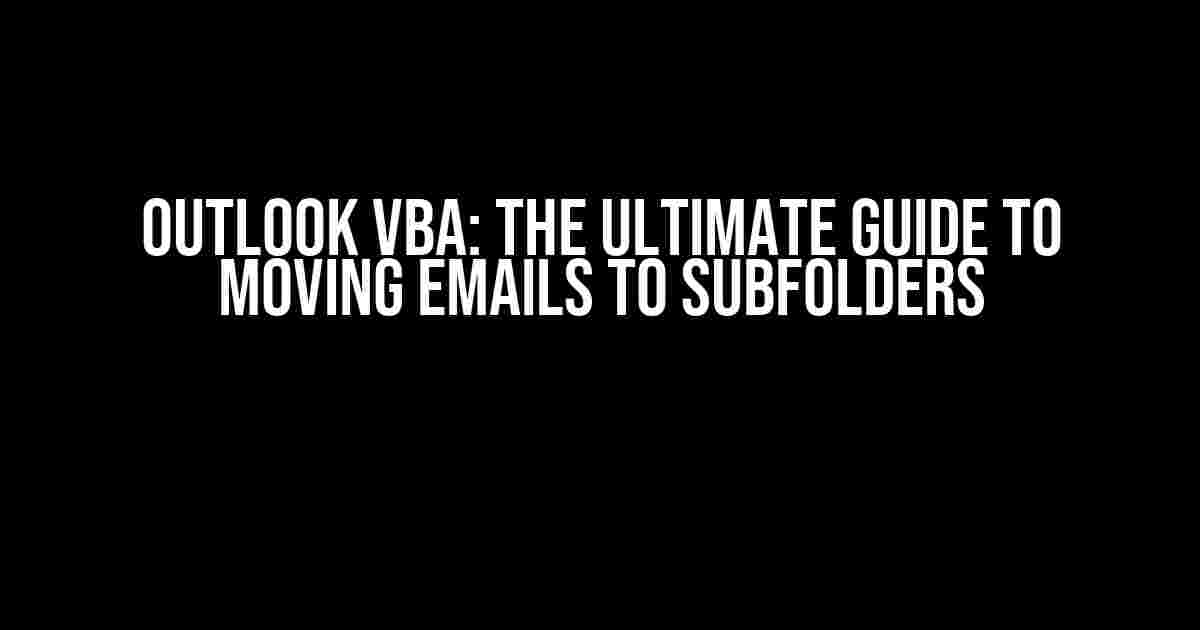Are you tired of spending hours sorting through your overflowing inbox, desperately trying to find that one important email? Do you find yourself constantly clicking on the “Move to Folder” button, only to end up with a gazillion subfolders and no clear organizational structure? Fear not, dear Outlook user, for we have the solution to your email woes! In this article, we’ll show you how to harness the power of Outlook VBA to move emails to subfolders with ease, freeing up your time for more important things… like checking your email.
What is Outlook VBA?
For the uninitiated, VBA stands for Visual Basic for Applications, which is a programming language built into Outlook (and other Microsoft Office applications). It allows you to create custom scripts, macros, and tools that automate tasks and enhance the user experience. In this case, we’ll be using VBA to create a script that moves emails to subfolders automatically.
Why Use Outlook VBA to Move Emails to Subfolders?
There are several reasons why using Outlook VBA to move emails to subfolders is a game-changer:
- Speed and Efficiency**: With a VBA script, you can move hundreds of emails to subfolders in a matter of seconds, saving you hours of manual labor.
- Consistency**: VBA ensures that your email organization system is consistent and follows a set of predetermined rules, eliminating human error.
- Customization**: You can tailor the script to fit your specific needs, whether it’s moving emails based on sender, subject, or content.
Setting Up Your Outlook VBA Environment
Before we dive into the coding part, let’s make sure you have the necessary tools and settings:
In Outlook, go to Developer > Visual Basic. If you don’t see the Developer tab, follow these steps:
- Go to File > Options.
- In the Outlook Options window, click on Customize Ribbon.
- Check the box next to Developer and click OK.
Now that you have the VBA editor open, let’s create a new module:
In the VBA editor, go to Insert > Module. This will create a new module where we’ll write our code.
The Code: Moving Emails to Subfolders
Here’s the code that will move emails to subfolders based on the sender’s email address:
Sub MoveEmailsToSubfolder()
' Set the source folder (inbox)
Dim olSourceFolder As MAPIFolder
Set olSourceFolder = Application.GetNamespace("MAPI").GetDefaultFolder(6)
' Set the target folder (subfolder)
Dim olTargetFolder As MAPIFolder
Set olTargetFolder = olSourceFolder.Folders("Subfolder Name")
' Loop through each email in the source folder
For Each olItem In olSourceFolder.Items
' Check if the email is from a specific sender
If olItem.SenderEmailAddress = "[email protected]" Then
' Move the email to the target folder
olItem.Move olTargetFolder
End If
Next olItem
End Sub
Let’s break down the code:
olSourceFolderis set to the inbox folder.olTargetFolderis set to the subfolder where we want to move the emails.- The script loops through each email in the source folder using a
For Eachloop. - For each email, it checks if the sender’s email address matches the specified address.
- If true, the email is moved to the target folder using the
.Movemethod.
Customizing the Script
The script above is just a starting point. You can customize it to fit your specific needs by modifying the following:
- Sender’s Email Address**: Change “[email protected]” to the email address you want to target.
- Target Folder**: Update “Subfolder Name” to the actual name of the subfolder you want to move emails to.
- Conditionals**: Add more conditionals to move emails based on other criteria, such as subject, body, or attachments.
Here are some examples of additional conditionals you can add:
' Move emails with a specific subject
If olItem.Subject = "Meeting Request" Then
olItem.Move olTargetFolder
End If
' Move emails with attachments
If olItem.Attachments.Count > 0 Then
olItem.Move olTargetFolder
End If
' Move emails from a specific domain
If InStr(olItem.SenderEmailAddress, "@example.com") > 0 Then
olItem.Move olTargetFolder
End If
Running the Script
To run the script, follow these steps:
- In the VBA editor, click on Run > Run Sub/User Form.
- Select the
MoveEmailsToSubfoldersubroutine and click Run.
The script will now move emails from the inbox to the specified subfolder based on the conditions set.
Tips and Variations
Here are some additional tips and variations to take your email organization to the next level:
- Create a Rule**: Create an Outlook rule that runs the script automatically when a new email arrives.
- Use RegEx**: Use regular expressions to match complex patterns in the sender’s email address or subject.
- Move Emails to Multiple Folders**: Modify the script to move emails to multiple folders based on different criteria.
- Create a UI**: Create a user interface that allows you to input the sender’s email address or subject dynamically.
| Tip | Description |
|---|---|
Use olItem.Move instead of olItem.Copy |
Moves the email to the target folder instead of copying it. |
Use olItem.Delete after moving |
Deletes the email from the source folder after moving it to the target folder. |
Use olItem.UnRead to mark emails as unread |
Marks the email as unread after moving it to the target folder. |
Conclusion
With this comprehensive guide, you should now be able to harness the power of Outlook VBA to move emails to subfolders with ease. Whether you’re a busy professional or a diligent email organizer, this script will save you hours of time and streamline your inbox management. So go ahead, get creative, and take your email organization to the next level!
Happy coding!
Frequently Asked Question
Here are some frequently asked questions about moving emails to subfolders using Outlook VBA.
How do I move an email to a subfolder using Outlook VBA?
You can use the `Move` method in Outlook VBA to move an email to a subfolder. Here’s an example code snippet: `objMail.Move objFolder.Folders(“SubfolderName”)`, where `objMail` is the email object and `objFolder` is the folder object containing the subfolder.
How do I get the folder object for a subfolder using Outlook VBA?
You can get the folder object for a subfolder using the `Folders` property of the parent folder object. For example, if you have a folder named “Inbox” and a subfolder named “Subfolder”, you can get the folder object for the subfolder using `Set objSubfolder = objFolder.Folders(“Subfolder”)`, where `objFolder` is the folder object for the “Inbox” folder.
How do I loop through all emails in a folder and move them to a subfolder using Outlook VBA?
You can use a `For Each` loop to loop through all emails in a folder and move them to a subfolder using the `Move` method. Here’s an example code snippet: `For Each objMail In objFolder.Items: objMail.Move objFolder.Folders(“SubfolderName”): Next`, where `objFolder` is the folder object containing the emails and `objMail` is the email object.
How do I move emails to a subfolder based on specific criteria using Outlook VBA?
You can use an `If` statement to check specific criteria, such as the email subject or sender, and then move the email to a subfolder using the `Move` method. For example: `If objMail.Subject = “Specific Subject” Then objMail.Move objFolder.Folders(“SubfolderName”)`, where `objMail` is the email object and `objFolder` is the folder object containing the subfolder.
How do I avoid errors when moving emails to a subfolder using Outlook VBA?
To avoid errors, make sure to check if the subfolder exists before trying to move the email to it. You can use the `FolderExists` function to check if the subfolder exists, and if not, create it using the `Add` method. Additionally, use error handling to catch any errors that may occur during the move process.


